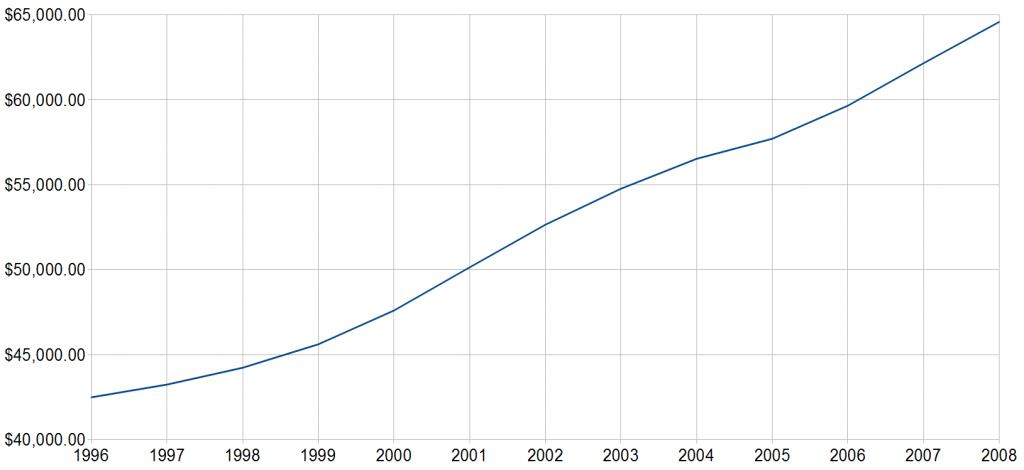The total amount of credit card debt owed by all Americans is around $800 billion dollars according to the Federal Reserve’s G.19 Consumer Credit data release. The New York Federal Reserve’s quarterly report on household debt and credit shows outstanding student loan debt at $867 billion dollars. To the learned mind, these numbers should frighten to near hysteria.
While there’s no doubt that higher education correlates to higher income, the statistics can be misleading; in 2009 a professional degree (lawyer, doctor, etc.) conferred a staggering 66% higher income than a master’s degree (the presumed next lowest level of education). This suggests that not all degrees are made equal (even in an adjusted man-year sense). But setting aside earning power considerations, the bigger problem is directly on the supply side.

President Obama has recently been pushing to keep federal student loan rates low, at a single year cost of $6 billion. The effort, while admirable, completely ignores the cost and benefit side of the equation, seeking simply to maintain essentially limitless access to cheap money. The frozen rate the President is aiming for is 3.4 percent, which in a market-based approach would imply that student loans (unbacked by collateral) are safer bets than mortgages, which are backed by real estate. This alone should raise eyebrows. However there are social implications: the government is right and just in promoting higher education in the same way that it promotes home ownership via federally secured loans and the mortgage interest deduction. But of course those who forget history are doomed to repeat it. One only has to look back to the housing collapse of the late 2000s to see the outcome of limitless cheap loans disconnected from true value and ability to repay. Much like the looming heath care cost crisis (which the President’s reform measures simply compound), the “purchasers” of student loans have become so disconnected from the actual cost of what they’re buying that the same deadly feedback loop that precipitated the housing crisis is reappearing in this market.
Evaluating how to adequately fund higher education requires reality checks on both sides of the equation. Just as unrealistic as it is to allow outdated labor models like protected tenure and boundless fringe benefits to continue to exist within our universities, the states themselves cannot honestly continue to cut state assistance and expect the schools to perform at the same levels. While these may superficially seem like opposing thought processes, both are fueled by the same disconnect from market forces that “blind” cheap loans provide: labor costs have no downward pressure when enrollment remains steady even though tuition increases because such increases are simply absorbed by one-mouse-click loans. Likewise states, who unlike the federal government more or less have to live within their means, see higher education costs as “low hanging fruit” at appropriations time since reduced funding will again simply be absorbed by higher borrowing by students. In both scenarios the artificially cheap and available loans provide no pressure against rising costs, leading to the situation we face today.
Much can be said about the finances of modern universities in America. But politically speaking (and as touched on earlier), both “sides”, those that advocate simply for lower costs and those that advocate for higher funding clearly must meet somewhere in the middle. Hoping for such a compromise, though, is highly optimistic. Attacking the pig at the trough, though, seems the best real-world scenario. By reforming the federal student loan programs pressure can be applied on both sides of the argument, forcing a compromise (as well as quite possibly averting an economic catastrophe like the housing collapse). The best way to do this is to stop treating all college as equal. Today an 18 year old can borrow \$60,000 to fund a basket-weaving degree, but would never be able to borrow that same \$60,000 to fund a house. Resolving such a dissonance should be of utmost priority.
America is sorely lacking in strong math and science graduates. I know, I interview people for engineering positions and routinely cannot find American graduates with the qualifications and skills compared to foreign students. This in the abstract is not a problem — companies should hire the most skilled talent they can find, regardless of ethnic and national background. But it does illuminate a serious problem: we’re spending more and more on education as a nation yet getting less and less as a result. Although controversial, means-testing student loan applicants based on chosen majors offers a quantitative way to provide value judgments to prospective borrowers.
Finding a way forward isn’t easy, but continuing on our current path is not an option. The truth is we’re doing a disservice to our youth when we burden them with long-term overpriced loans they can’t afford. Delaying this truth via an extension of cheap interest rates isn’t the solution.
This work is licensed under a Creative Commons Attribution-ShareAlike 4.0 International License.
Leave a Reply